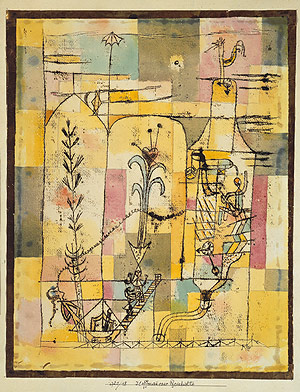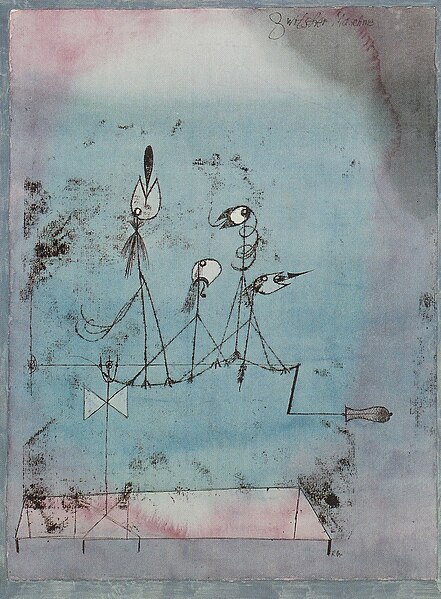

Klee has been variously associated with Expressionism, Cubism, Futurism, Surrealism, and Abstraction, but his pictures are difficult to classify. He generally worked in isolation from his peers, and interpreted new art trends in his own way. He was inventive in his methods and technique. Klee worked in many different media—oil paint, watercolor, ink, pastel, etching, and others. He often combined them into one work. He used canvas, burlap, muslin, linen, gauze, cardboard, metal foils, fabric, wallpaper, and newsprint. Klee employed spray paint, knife application, stamping, glazing, and impasto, and mixed media such as oil with watercolor, water color with pen and India ink, and oil with tempera.
He was a natural draftsman, and through long experimentation developed a mastery of color and tonality. Many of his works combine these skills. He uses a great variety of color palettes from nearly monochromatic to highly polychromatic. His works often have a fragile child-like quality to them and are usually on a small scale. He often used geometric forms as well as letters, numbers, and arrows, and combined them with figures of animals and people. Some works were completely abstract. Many of his works and their titles reflect his dry humor and varying moods; some express political convictions. They frequently allude to poetry, music and dreams and sometimes include words or musical notation. The later works are distinguished by spidery hieroglyph-like symbols. Rainer Maria Rilke wrote about Klee in 1921, “Even if you hadn’t told me he plays the violin, I would have guessed that on many occasions his drawings were transcriptions of music.”
Pamela Kort observed: "Klee's 1933 drawings present their beholder with an unparalleled opportunity to glimpse a central aspect of his aesthetics that has remained largely unappreciated: his lifelong concern with the possibilities of parody and wit. Herein lies their real significance, particularly for an audience unaware that Klee's art has political dimensions."

Klee suffered from a wasting disease, scleroderma, toward the end of his life, enduring pain that seems to be reflected in his last works of art. One of his last paintings, "Death and Fire", features a skull in the center with the German word for death, "Tod", appearing in the face. He died in Muralto, Locarno, Switzerland, on June 29, 1940 without having obtained Swiss citizenship, despite his birth in that country. His art work was considered too revolutionary, even degenerate, by the Swiss authorities, but eventually they accepted his request six days after his death.] His legacy comprises about 9,000 works of art. The words on his tombstone, Klee's credo, placed there by his son Felix, say, "I cannot be grasped in the here and now, For my dwelling place is as much among the dead, As the yet unborn, Slightly closer to the heart of creation than usual, But still not close enough." He was buried at Schosshaldenfriedhof, Bern, Switzerland.






